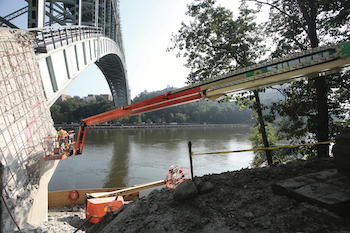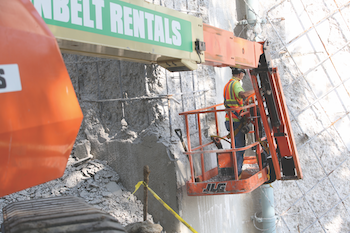Rental Solutions -- Tracks add access
Crawler boom lift makes bridge rehab possible.
“Delicate” isn’t typically the first word that comes to mind when you think about demolition. At its heart, the word evokes dynamite, debris, clouds of smoke and wrecking balls, at a minimum. But when it comes to demolishing and replacing concrete piers on an 82-year-old bridge that carries more than 64,000 vehicles into and out of New York City every day, everything about the process is, in fact, delicate.
 |
| To gain skewback access, the tracked boom lifts had to move down banks with nearly a 50 percent grade. Crews are chiseling approximately 12 inches from every skewback face and then reface it with new material. |
 |
| Demolishing and replacing concrete piers on an 82-year-old Henry Hudson bridge that carries more than 64,000 vehicles into and out of New York City every day is possible with JLG 400SC tracked boom lifts. |
 |
| “Without the 400SC, we would be significantly delayed and would have been forced to bring equipment in on barges, which is expensive and potentially dangerous with the swift current, not to mention the environmental hurdles we would have faced,” says Edgar Vidal, general superintendent for Tutor Perini. |
The Henry Hudson Bridge, predicted to be named a registered historical landmark, is a critical lifeline of access that connects the northern end of Manhattan to the Bronx.
Its concrete base supports are showing signs of its revered and nostalgic history. In need of repair, the New York Metropolitan Transportation Authority and its contractor, Tutor Perini, have started the painstaking process of chiseling away the 82-year-old concrete on each bridge support, skewback and pedestal at a time, and replacing or repairing each one over the course of nearly 19 months.
Atypical demolition
Unlike a typical bridge demolition project, this one requires precision because the bridge will remain open during the entire project. There is no room for error and every detail is critical, including the selection of construction equipment. Site access is one of the greatest project challenges.
The bridge is located in an area where the river bank has about a 50 percent grade, making it difficult to ger equipment close to the bridge’s four skewbacks that carry most of the weight of the bridge.
Unlike the pillars, which are being completely replaced, the skewbacks will have approximately 12 inches of concrete chiseled away from every face and will be refaced with new material.
Perfect access
“It’s rare, but there are times in construction projects when there truly is a unique product that is the best-and-only in its class,” says Edgar Vidal, general superintendent for Tutor Perini.
“We were facing a significant slope down to the river, and another manufacturer’s machine had already failed the test. In a second attempt, our rental supplier had acquired for us the JLG 400SC crawler boom. The machine descended the slope, which at the time was mud and rock, with little effort and took its place at the water’s edge, allowing us to move forward with the demolition project. This machine was destined for this type of work.”
Since the start of the project, three additional 400SC models have been added to the work site, allowing the project to remain on schedule. The four machines, the newest boom lifts in JLG’s lineup, are the first of their kind working in the United States.
“These machines are my savior,” says Vidal. “Without the 400SC, we would be significantly delayed and would have been forced to bring equipment in on barges, which is expensive and potentially dangerous with the swift current, not to mention the environmental hurdles we would have faced.”
The JLG 400SC lift uses tracks instead of wheels, which makes it possible to use on challenging terrain.
The tracks offer flotation so surface pressure gets evenly distributed across the length of the tracks. It can travel on muddy or soft ground that would quickly mire a piece of equipment with tires. Its compact design allows it to access challenging work sites where space is very limited.
“The tracks provide operators with the ability to work in areas where traditional booms can’t due to ground conditions, including snow and mud,” says Brandon Tucker, senior director of engineering for JLG. “The Hudson River Bridge project is exactly the type of environment that our engineers envisioned when they designed this machine, and the customer feedback is reassuring.”
“Without the 400SC, we would be significantly delayed and would have been forced to bring equipment in on barges, which is expensive and potentially dangerous with the swift current, not to mention the environmental hurdles we would have faced,” says Edgar Vidal, general superintendent for Tutor Perini.










